| |
Switching from suppressive protease inhibitor-based regimens to nevirapine-based regimens: a meta-analysis of randomized controlled trials
|
| |
| |
HIV Medicine
Volume 9, Issue 9, Pages 747-756
Oct 2008
J Ena 1 , A Leach 1 and P Nguyen 1
1 Hospital Marina Baixa, Internal Medicine, Villajoyosa, Alicante, Spain
"our meta-analysis of six trials shows that replacing PIs with NVP may be as effective to maintain virological suppression as continuing PI-based therapy. Clinical scenarios in which this simplification regimen could be considered are patients with dyslipidaemia or patients with high cardiovascular risk. In addition, the lower pill burden, lack of need for storage under refrigeration, increased availability, and lower cost make this strategy attractive. It should be taken into account that patients with hepatitis C or B virus infection should be carefully monitored to prevent severe liver toxicity or skin reactions during the treatment....
...In our meta-analysis we observed that replacement of a PI by NVP had similar efficacy as continuation of PI-based therapy to maintain virological suppression. By intention-to-treat analysis, 81.2% of patients in the NVP group maintained viral suppression at the end of follow-up compared with 77.7% in the PI group. By on-treatment analysis, the figures were 91.1 and 88.5%, respectively. The efficacy of this strategy was similar to that reported for EFV substitution of PI-based therapy [31]....
...The rate of hepatotoxicity leading to NVP discontinuation ranged in the literature from 12.5 to 21% in ARV-naive patients [32-34]. In most studies the risk was greater among persons with chronic viral hepatitis [32-33]. However, the risk of NVP discontinuation was lower in antiretroviral therapy-experienced patients than in ARV-naive patients in the EuroSIDA cohort, even in those with high CD4 cell counts [35]. A study conducted in India using generic NVP-based therapy in ARV-experienced men and women with elevated CD4 cell counts found no cases of severe hepatotoxicity [36]. It should be emphasized that patients on PIs were tolerating these drugs reasonably well, while the introduction of NVP runs the unavoidable risk of toxicity associated with this drug. Nevertheless, our meta-analysis showed no differences in the overall withdrawal rate between the two arms....
....In other evaluated outcomes, such as modifications in lipid profiles and body shape measurements, the analysis found no significant differences in patients treated with NVP compared with those who continued with PIs. However, in previous studies in which NVP was compared with boosted PI-based therapies, greater improvements in lipid profiles were demonstrated [37]. Two studies reported significant improvement of QoL at the end of follow-up in patients receiving NVP compared with those on PI-based therapy."
ABSTRACT
Objectives: We performed a meta-analysis to assess the efficacy and safety of switching from protease inhibitor (PI)- to nevirapine (NVP)-based regimens in HIV-infected patients in whom virological suppression had been achieved.
Methods: Six trials (550 patients) were analysed. The demographics showed that 11-48% of participants were female and 40-53% had hepatitis C or B virus infection, and the mean CD4 lymphocyte count was >500 cells/μL at study entry.
Results: NVP-based regimens showed noninferiority compared with continuation of PI therapy to maintain virological suppression in 'intention to treat' (80 vs. 78%; P=0.35) and 'on treatment' analyses (91 vs. 89%; P=0.10). Overall rates of discontinuation because of adverse events were similar in the two groups (11 vs. 10%; P=0.79). However, NVP-based therapies caused more discontinuations because of liver toxicity than PI-based therapies (7 vs. 0%; P=0.0009). At the end of follow-up there was no statistical difference in CD4, cholesterol, triglyceride and body shape measurements between the two groups. Two studies reported greater improvement in quality of life in patients who were switched to the NVP group.
Conclusions: Switching from suppressive PI- to NVP-based regimens is virologically and immunologically safe; however, the risk of liver toxicity requires monitoring of clinical symptoms and liver chemistry during NVP therapy.
In order to reduce the risk of metabolic side effects attributable to long-term protease inhibitor (PI)-based therapies and to improve adherence to simpler regimens, physicians and patients often wish to switch from complex PI-based regimens to simpler regimens with non-PI-based therapies.
Currently, the three non-PI-based regimens most often used are combinations of two nucleoside (or one nucleotide and one nucleoside) reverse transcriptase inhibitors with abacavir (ABC), efavirenz (EFV) or nevirapine (NVP). ABC is a nucleoside reverse transcriptase inhibitor (NRTI) that can produce fatal hypersensitivity reactions [1,2]. The superiority of EFV- and NVP-based regimens has relegated nucleoside combinations with ABC to selected patients, including some with active tuberculosis and some pregnant women [3-5]. EFV is a nonnucleoside reverse transcriptase inhibitor (NNRTI) showing potent and durable efficacy but it has multiple central nervous system side effects such as disturbances of sleep architecture, morning dizziness and drowsiness [6]. A history of mental disorder predisposes for EFV neuropsychiatric disturbances [7]; further disadvantages of EFV include gynaecomastia and dyslipidaemia [8,9]. NVP is an NNRTI which has shown comparable HIV suppression in combination therapies to that achieved with EFV-based regimens [3-5]. A number of noncontrolled trials have also shown that NVP can successfully maintain HIV suppression in more than 90% of patients when PIs are substituted for NVP-based regimens [10-14]. Hepatitis B or C virus infections predispose to liver toxicity caused by NVP [15-17]; NVP can also cause pruritic rash leading to discontinuation, mainly in women [18,19]. It has been recommended that patients should be closely monitored at baseline and for the first 18 weeks for signs of potentially life-threatening liver or skin reactions. The greatest risk of severe rash or hepatic events (often associated with rash) occurs within the first 6 weeks of therapy. However, the risk of any hepatic event, with or without rash, continues past this period and monitoring should continue at frequent intervals.
Recently, the US Food and Drug Administration and the European Agency for the Evaluation of Medicinal Products have issued a warning in the NVP package-insert recommending that NVP not be initiated in adult women with CD4 lymphocyte counts >250 cells/μL or in adult men with counts >400 cells/μL because of the higher risk of life-threatening hepatotoxicity. The data were mainly derived from a retrospective analysis of the Boehringer-Ingelheim databases, which contain data on antiretroviral (ARV)-naive patients almost exclusively [20].
Although some randomized controlled trials showed virological control when patients were switched from PI-based therapies to NVP, these studies lacked sufficient power to conclude that NVP was not inferior (or equivalent) to a continued PI-based regimen. Therefore, we performed a meta-analysis of randomized controlled trials to examine whether it is virologically and clinically safe to switch patients on PI-based regimens, in whom virological suppression has been achieved, to a simplified regimen with two NRTIs and NVP.
Discussion
In our meta-analysis we observed that replacement of a PI by NVP had similar efficacy as continuation of PI-based therapy to maintain virological suppression. By intention-to-treat analysis, 81.2% of patients in the NVP group maintained viral suppression at the end of follow-up compared with 77.7% in the PI group. By on-treatment analysis, the figures were 91.1 and 88.5%, respectively. The efficacy of this strategy was similar to that reported for EFV substitution of PI-based therapy [31].
Our conclusions were insensitive to a number of potential sources of heterogeneity, including time of measurement of outcomes, lower limit of HIV RNA detection, proportion of female participants, proportion of patients with hepatitis C or B virus infection and quality of trials. The safety analysis showed a 7% rate of severe hepatotoxicity leading to drug discontinuation in patients treated with NVP. However, the overall withdrawal because of side effects was 10% in both regimens.
The rate of hepatotoxicity leading to NVP discontinuation ranged in the literature from 12.5 to 21% in ARV-naive patients [32-34]. In most studies the risk was greater among persons with chronic viral hepatitis [32-33]. However, the risk of NVP discontinuation was lower in antiretroviral therapy-experienced patients than in ARV-naive patients in the EuroSIDA cohort, even in those with high CD4 cell counts [35]. A study conducted in India using generic NVP-based therapy in ARV-experienced men and women with elevated CD4 cell counts found no cases of severe hepatotoxicity [36]. It should be emphasized that patients on PIs were tolerating these drugs reasonably well, while the introduction of NVP runs the unavoidable risk of toxicity associated with this drug. Nevertheless, our meta-analysis showed no differences in the overall withdrawal rate between the two arms.
In other evaluated outcomes, such as modifications in lipid profiles and body shape measurements, the analysis found no significant differences in patients treated with NVP compared with those who continued with PIs. However, in previous studies in which NVP was compared with boosted PI-based therapies, greater improvements in lipid profiles were demonstrated [37]. Two studies reported significant improvement of QoL at the end of follow-up in patients receiving NVP compared with those on PI-based therapy. Improvements in QoL in terms of physical health summary score were reported in a study comparing an NVP-based regimen with a nelfinavir-based regimen [38].
Our results are consistent with a previous meta-analysis that included two of the six trials analysed here [31]. The strengths of the present analysis include its explicit inclusion criteria (limiting eligible studies to randomized trials), a comprehensive literature search, and a sample large enough to detect clinically meaningful differences. To assess noninferiority between study arms in the efficacy analysis, the required sample size was a total of 277 participants in each group. This estimate of sample size was obtained under the assumption of 80% efficacy in maintaining virological suppression at 48 weeks in patients who continue PI-based therapy [39] and an 80% power to detect a lower limit difference not >-5% in the outcomes evaluated in the NVP and PI groups. The lower limit of the pooled RD was selected based on the recommendations of the limits of noninferiority proposed by the European Agency for the Evaluation of Medicinal Products [40].
Our meta-analysis had some limitations. Importantly, the studies were carried out in Spain and Italy, where injecting drug use is the main transmission category for HIV and hepatitis C virus. Therefore, rates of withdrawal because of liver toxicity may be lower in populations with a lower prevalence of chronic hepatitis C virus infection. Also, our results are restricted to regimens that have been available for at least several years and more recently introduced ARV agents were poorly represented. For example, our conclusions may not apply to newer PIs with more favourable lipid profiles, such as atazanavir, or to boosted PIs (such as lopinavir/RTV), which have shown greater potency and better adherence than their unboosted counterparts. An additional drawback is the lack of access to original source data, which would have enabled time-to-event analysis for severe adverse events. Finally, the relatively small number of trials limited the assessment for sources of heterogeneity.
There are several areas requiring improvement in terms of the conduct and reporting of ARV drug trials. Most trials included in this meta-analysis did not report randomization or allocation concealment methods in enough detail to allow appraisal of whether they were appropriate. Moreover, most of the studies were open-label design. Open-label design usually exaggerates estimates of treatment effect compared with blind studies. Finally, trials did not report usable data on the evaluation of body shape changes, and very few of them reported a common score for QoL assessment to allow comparisons to be made.
Despite the potential limitations, our meta-analysis of six trials shows that replacing PIs with NVP may be as effective to maintain virological suppression as continuing PI-based therapy. Clinical scenarios in which this simplification regimen could be considered are patients with dyslipidaemia or patients with high cardiovascular risk. In addition, the lower pill burden, lack of need for storage under refrigeration, increased availability, and lower cost make this strategy attractive. It should be taken into account that patients with hepatitis C or B virus infection should be carefully monitored to prevent severe liver toxicity or skin reactions during the treatment.
Results
Trial flow
Figure 1 shows the flow of studies from identification through to final inclusion in our review. We identified a total of 141 citations through electronic database searches, hand searches and searching of reference lists. From these citations we identified six trials that met the inclusion criteria. Two additional trials meeting inclusion criteria were identified from the Boehringer-Ingelheim registry, but we were unable to obtain additional data from the investigators. Table 1 shows details of the six trials meeting the inclusion criteria [25-30]. The two investigators were in agreement for 91% of article selection and 95% of initial quality ratings.
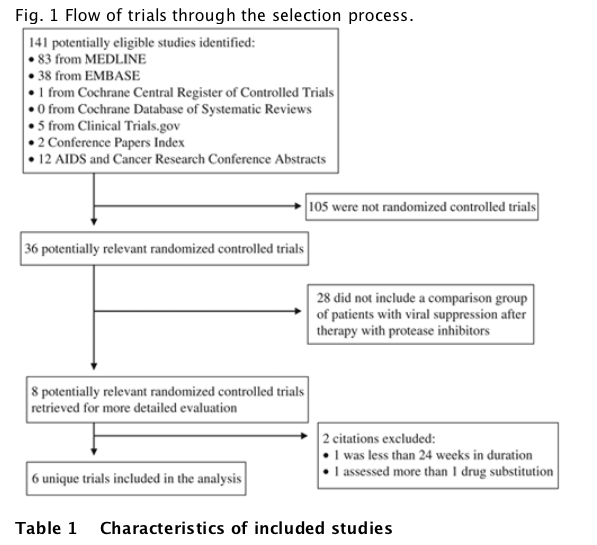
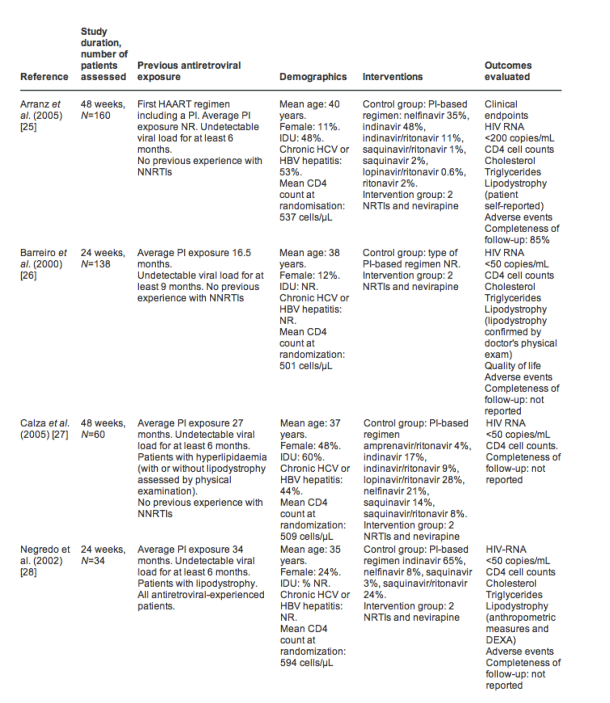
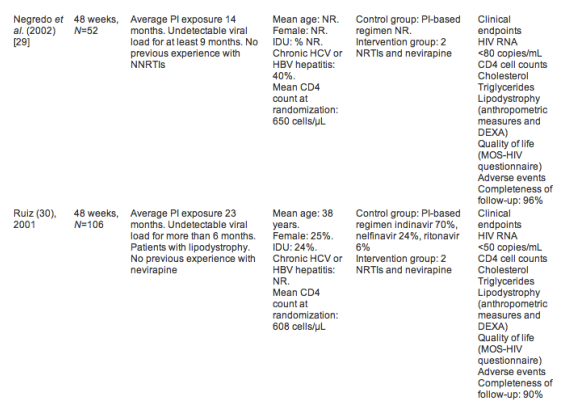
Study characteristics
A total of 550 patients (six trials) with undetectable HIV RNA were randomized to have the PI, in most cases unboosted with ritonavir (RTV), replaced with NVP (NVP group) or to continue with PI-based therapy (PI group). Five trials were conducted in Spain and one in Italy. The proportion of female participants was 11-48%. The prevalence of chronic hepatitis B or C virus infection in HIV-infected patients varied from 40 to 53% in the studies that reported this feature. At study entry, patients had a mean CD4 count >500 cells/μL in all trials. Two studies reported outcomes at <48 weeks and four at 48 weeks of follow-up. Only one study [25] reported data on clinical progression, defined as death or new AIDS-defining events; there were a total of three deaths, none of them directly related to HIV infection. Only one study [27] reported the randomization method and the blinding of physicians and patients, and described withdrawals and drop-outs. In all other trials, the randomization and allocation concealment methods were not described. The remaining five studies were randomized with description of reasons for patients not completing the trial period (also know as patient drop-outs) [26-30]. One study [27] evaluated the substitution of NVP or EFV for a PI vs. lipid-lowering therapy for the management of dyslipidaemia; this study provided outcomes for virological suppression and CD4 lymphocyte counts but not for lipid or adverse event outcomes.
Quantitative data synthesis
By intention-to-treat analysis, 80% of patients in the NVP group maintained viral suppression at the end of follow-up compared with 78% in the PI group (pooled RD 3%; 95% CI -4 to 9%) (Fig. 2). By on-treatment analysis the figures were 91 vs. 88%, respectively (pooled RD 3%; 95% CI -2 to 7%). No heterogeneity was present in either analysis (I2=0%, P=0.60 and I2=7.4%, P=0.41, respectively) (Fig. 3).
Fig. 2 Efficacy, in intention-to-treat analysis, of switching to nevirapine-based therapy or continuing with protease inhibitor (PI)-based therapy to maintain HIV RNA below the detection limit at the end of follow-up. CI, confidence interval; n, number of patients experiencing the outcome; N, total number of patients; RD, risk difference. Refers to the contribution of each study to the overall estimate (larger studies with more events are given more weights).
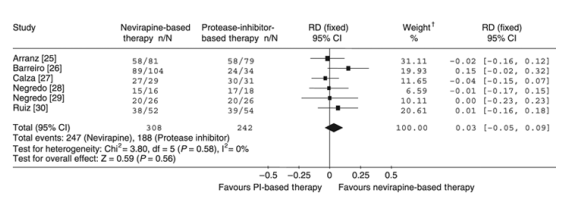
Fig. 3 Efficacy, in on-treatment analysis, of switching to nevirapine-based therapy or continuing with protease inhibitor (PI)-based therapy to maintain HIV RNA below the detection limit at the end of follow-up. CI, confidence interval; n, number of patients experiencing the outcome; N, total number of patients; RD, risk difference. Refers to the contribution of each study to the overall estimate (larger studies with more events are given more weights).
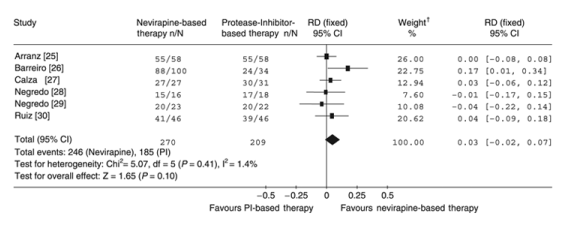
In subgroup analysis for the virological suppression outcome, follow-up (P=0.16), lower limit of HIV RNA detection (P=0.86), study quality (P=0.55), proportion of female participants (P=0.70) and proportion of patients with chronic hepatitis B or C virus infection (P=0.50) were not associated with heterogeneity (Table 2).
Table 2 Virological suppression trials of nevirapine simplification vs. continuation of protease inhibitor-containing regimens
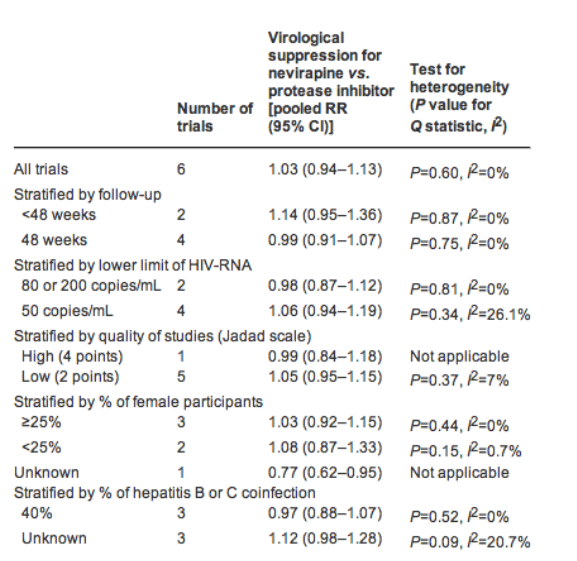
The mean CD4 cell count increase in the NVP group was not significant at the end of follow-up compared with the PI group (weighted mean difference 17.90 cells/μL; 95% CI -23.59 to 59.39; test for heterogeneity I2=91.7%, P<0.00001). No significant change in the lipid profiles was observed for cholesterol (weighted mean difference -17.78 mg/dL; 95% CI -40.69 to 5.13) or triglycerides (weighted mean difference -47.95 mg/dL; 95% CI -116.81 to 20.90). Lipid outcomes were associated with significant heterogeneity between trials (I2=98.4%, P<0.00001, and I2=92.7%, P<0.00001, respectively). Two studies [25,26] described amelioration of lipodystrophy in the NVP group, whereas the remaining four studies did not demonstrate any significant improvement in (or any significant worsening of) fat redistribution during follow-up. QoL was evaluated in three studies [26,29,30]. Two studies used a common five-point scale: a score of 1 indicated a QoL much worse than, 5 indicated a QoL much better than, and 3 indicated a QoL equal to that at last visit [29-30]. Patients switched to NVP had greater improvements in QoL compared with those who continued PI-based therapy (weighted mean difference 1.40 points; 95% CI 1.22-1.58; P< 0.00001; I2=0%).
Overall withdrawal because of adverse events occurred in 10.3% of patients in the NVP group and in 10.2% in the PI group (pooled RD 0.1%; 95% CI -5% to 6%; P=0.93), with no heterogeneity detected (I2=0%) (Fig. 4). However, grade 3 or 4 liver toxicity leading to drug discontinuation [25,28-30] was more common in patients who switched to the NVP group (13 of 175) compared with those who continued with PI-based therapy (0 of 177) (pooled RD 7%; 95% CI 3-12%; P=0.0009), with no heterogeneity detected among trials (I2=0%) (Fig. 5). There were no deaths attributable to adverse events.
Fig. 4 Risk of developing any adverse event requiring drug discontinuation. CI, confidence interval; n, number of patients experiencing the outcome; N, total number of patients; RD, risk difference. Refers to the contribution of each study to the overall estimate (larger studies with more events are given more weights).
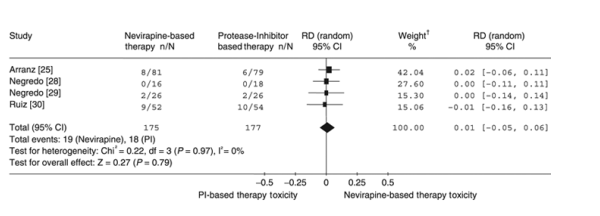
Fig. 5 Risk of developing severe liver toxicity requiring drug discontinuation. CI, confidence interval; n, number of patients experiencing the outcome; N, total number of patients; RD, risk difference. Refers to the contribution of each study to the overall estimate (larger studies with more events are given more weights).
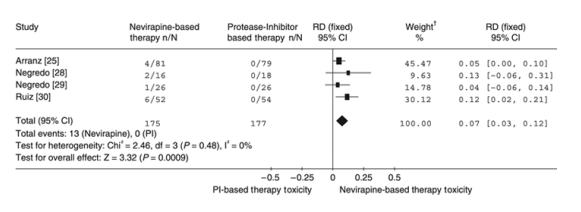
The funnel plot suggested the possibility of publication bias for the virological suppression outcome by intention-to-treat analysis (P=0.046) but not by on-treatment analysis (P=0.654). There was no publication bias for withdrawals because of adverse events (P=0.073).
Discussion
In our meta-analysis we observed that replacement of a PI by NVP had similar efficacy as continuation of PI-based therapy to maintain virological suppression. By intention-to-treat analysis, 81.2% of patients in the NVP group maintained viral suppression at the end of follow-up compared with 77.7% in the PI group. By on-treatment analysis, the figures were 91.1 and 88.5%, respectively. The efficacy of this strategy was similar to that reported for EFV substitution of PI-based therapy [31].
Our conclusions were insensitive to a number of potential sources of heterogeneity, including time of measurement of outcomes, lower limit of HIV RNA detection, proportion of female participants, proportion of patients with hepatitis C or B virus infection and quality of trials. The safety analysis showed a 7% rate of severe hepatotoxicity leading to drug discontinuation in patients treated with NVP. However, the overall withdrawal because of side effects was 10% in both regimens.
The rate of hepatotoxicity leading to NVP discontinuation ranged in the literature from 12.5 to 21% in ARV-naive patients [32-34]. In most studies the risk was greater among persons with chronic viral hepatitis [32-33]. However, the risk of NVP discontinuation was lower in antiretroviral therapy-experienced patients than in ARV-naive patients in the EuroSIDA cohort, even in those with high CD4 cell counts [35]. A study conducted in India using generic NVP-based therapy in ARV-experienced men and women with elevated CD4 cell counts found no cases of severe hepatotoxicity [36]. It should be emphasized that patients on PIs were tolerating these drugs reasonably well, while the introduction of NVP runs the unavoidable risk of toxicity associated with this drug. Nevertheless, our meta-analysis showed no differences in the overall withdrawal rate between the two arms.
In other evaluated outcomes, such as modifications in lipid profiles and body shape measurements, the analysis found no significant differences in patients treated with NVP compared with those who continued with PIs. However, in previous studies in which NVP was compared with boosted PI-based therapies, greater improvements in lipid profiles were demonstrated [37]. Two studies reported significant improvement of QoL at the end of follow-up in patients receiving NVP compared with those on PI-based therapy. Improvements in QoL in terms of physical health summary score were reported in a study comparing an NVP-based regimen with a nelfinavir-based regimen [38].
Our results are consistent with a previous meta-analysis that included two of the six trials analysed here [31]. The strengths of the present analysis include its explicit inclusion criteria (limiting eligible studies to randomized trials), a comprehensive literature search, and a sample large enough to detect clinically meaningful differences. To assess noninferiority between study arms in the efficacy analysis, the required sample size was a total of 277 participants in each group. This estimate of sample size was obtained under the assumption of 80% efficacy in maintaining virological suppression at 48 weeks in patients who continue PI-based therapy [39] and an 80% power to detect a lower limit difference not >-5% in the outcomes evaluated in the NVP and PI groups. The lower limit of the pooled RD was selected based on the recommendations of the limits of noninferiority proposed by the European Agency for the Evaluation of Medicinal Products [40].
Our meta-analysis had some limitations. Importantly, the studies were carried out in Spain and Italy, where injecting drug use is the main transmission category for HIV and hepatitis C virus. Therefore, rates of withdrawal because of liver toxicity may be lower in populations with a lower prevalence of chronic hepatitis C virus infection. Also, our results are restricted to regimens that have been available for at least several years and more recently introduced ARV agents were poorly represented. For example, our conclusions may not apply to newer PIs with more favourable lipid profiles, such as atazanavir, or to boosted PIs (such as lopinavir/RTV), which have shown greater potency and better adherence than their unboosted counterparts. An additional drawback is the lack of access to original source data, which would have enabled time-to-event analysis for severe adverse events. Finally, the relatively small number of trials limited the assessment for sources of heterogeneity.
There are several areas requiring improvement in terms of the conduct and reporting of ARV drug trials. Most trials included in this meta-analysis did not report randomization or allocation concealment methods in enough detail to allow appraisal of whether they were appropriate. Moreover, most of the studies were open-label design. Open-label design usually exaggerates estimates of treatment effect compared with blind studies. Finally, trials did not report usable data on the evaluation of body shape changes, and very few of them reported a common score for QoL assessment to allow comparisons to be made.
Despite the potential limitations, our meta-analysis of six trials shows that replacing PIs with NVP may be as effective to maintain virological suppression as continuing PI-based therapy. Clinical scenarios in which this simplification regimen could be considered are patients with dyslipidaemia or patients with high cardiovascular risk. In addition, the lower pill burden, lack of need for storage under refrigeration, increased availability, and lower cost make this strategy attractive. It should be taken into account that patients with hepatitis C or B virus infection should be carefully monitored to prevent severe liver toxicity or skin reactions during the treatment.
|
|
| |
| |
|
|
|